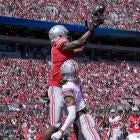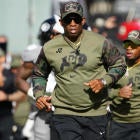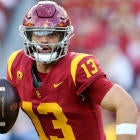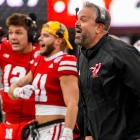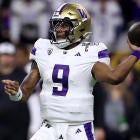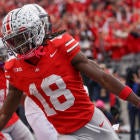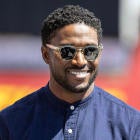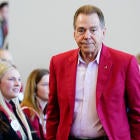More: O'Bannon news | On CFB: Dennis Dodd | Jeremy Fowler | Jon Solomon
OAKLAND, Calif. — The definitions of a cartel kept frustrating U.S. District Judge Claudia Wilken. Near the end of Thursday’s session at the Ed O’Bannon v. NCAA trial, Wilken alternated between rubbing and shaking her head in exasperation as she pressed NCAA economic expert Daniel Rubinfeld for clear definitions of three terms he used -- cartel, classic cartel and joint venture.
The confusion later led to this question of NCAA attorney Greg Curtner outside the courtroom: So is the NCAA a cartel?
“It is a cartel that does good things, as opposed to a cartel that does bad things,” Curtner said. “It’s not a classic cartel, as Rubinfeld used the terms. But it’s a joint venture in that it creates a new product of amateur sports and all of the things that go with that. It’s a partially integrated joint venture, is the right economic way to think about it.”
On the eve of the 15th and final day of the O’Bannon trial, the NCAA reached the point where it reluctantly called itself a cartel. The public optics of such a definition may not look good. But that’s what can happen at a trial defending the rules that ban college players from being paid from their names, images and likenesses (NILs).
Curtner said the NCAA resembles some cartels, but not a classic cartel because it doesn’t restrict output in order to raise prices and maximize profits. O’Bannon attorney Michael Hausfeld put it another way, quoting Scottish economist Adam Smith from his 1776 book, “The Wealth of Nations”:
“People of the same trade seldom meet together, even for merriment and diversion, but the conversation ends in a conspiracy against the public, or in some contrivance to raise prices.”
Wilken chuckled at the reference. The cartel issue was always going to be tricky for the NCAA to navigate. Rubinfeld, an economics professor at the University of California-Berkeley and an important NCAA expert, explicitly wrote in a microeconomics textbook more than 25 years ago that the NCAA is a cartel. The textbook has been reprinted with the same passages through the years.
“The cartel organization is the National Collegiate Athletic Association (NCAA),” Rubinfeld’s textbook said. “The NCAA restricts competition in a number of important ways. To reduce bargaining power by student-athletes, the NCAA creates and enforces rules regarding eligibility and terms of compensation.”
Rubinfeld chose Thursday to call the NCAA a “joint venture” as a subset to define “cartel.” “Some cartels may be illegal, some cartels may not be illegal,” he said.
While jotting down notes, Wilken finally agreed on definitions for Rubinfeld’s terms because, Wilken said, “I want to know what you mean so when I listen to your testimony I know what you’re talking about.” The definitions:
* Cartel: A group of firms that impose restraint. In the NCAA's case, the restraint is not allowing players to be paid. Said Curtner: “Mr. Hausfeld keeps bringing up restraint, restraint, restraint. We acknowledge there’s a restraint. That’s what creates the product as a differentiated product.” As recently as Wednesday, NCAA chief legal officer Donald Remy described the NCAA not paying players as "alleged restraints."
* Classic cartel: A group of firms that conspires to impose a restraint that reduces output without a pro-competitive justification. Rubinfeld and the NCAA say the NCAA is not a classic cartel. They're banking on amateurism, competitive balance, output or academic/athletic integration as a better reason to not let players be paid than the alleged harm.
* Joint venture: A group of firms that impose restraint and may or may not have a pro-competitive benefit. The NCAA characterizes itself as a joint venture that can have restraints that are reasonably necessary for a valid purpose. Both sides agree a joint venture can violate antitrust law.
Rubinfeld’s textbook described college athletics as “a big -- and an extremely profitable -- industry” in which “the inputs to production are the coaches, student-athletes and capital in the form of stadiums and playing fields.” Hausfeld tried to show that the costs of stadiums and coaches aren’t fixed, yet athletes are a fixed cost. Rubinfeld and Hausfeld went round and round on whether the athletic scholarship is a fixed price. Rubinfeld finally passed the answer off to NCAA vice president Mark Lewis for his Friday testimony, saying Lewis may know certain items athletes receive that exceed the athletic scholarship.
Why didn’t Rubinfeld use terms such as classic cartel and joint venture in his textbook all those years ago? Said Curtner: “I think he gave the best answer he’s going to give on that and that he was trying to create a provocative learning moment for his students.”
Needless to say, Rubinfeld said he will likely revise his textbook’s definition of NCAA cartel to include joint venture. Elsewhere in Day 14 of the O’Bannon trial:
Wilken’s questions and comments. At this stage in the trial, whenever Wilken talks, there’s increased interest in what she says. There was a dispute between the O’Bannon and NCAA lawyers about whether Rubinfeld could be asked about deferring payments to players in trust funds. NCAA lawyer Glenn Pomerantz said he would gladly not ask trust fund questions if that topic was off the table. “They’re certainly not off the table,” Wilken responded.
Given that there’s discussion of coaches’ salaries, Wilken asked what’s the contribution to winning in relation to players vs. coaches. Pomerantz said Lewis, an NCAA VP and a former Georgia football player, can touch on that question Friday.
Rubinfeld showed that under one plaintiffs’ model to share half of the TV revenue, a Washington State basketball player would make $174,454 over four years compared to $37,803 for a Gonzaga player. The NCAA’s point: Money would lure players to schools and impact competitive balance, an argument recent Vanderbilt football player Chase Garnham acknowledged at trial.
Wilken kept repeating that those potential TV dollars are still retained by schools today, only they allocate the dollars elsewhere. “Coaches, facilities, other recruiting tactics,” she said. Wilken asked whether competitive balance contributes to the popularity of college sports and if the topic should even be an economic question as opposed to a sports question.
Rubinfeld said if players are paid, he believes a Division 4 would emerge with pro players and thus decrease the number of games because schools wouldn’t play Division 4 teams. In other words, output would be reduced -- one of the NCAA's pro-competitive justifications.
Wilken questioned why there would be fewer games since teams that don’t pay players could then play different schools. Rubinfeld said there would be fewer desirable opponents in the new Division I among non-paying members so schools might reduce the number of games they play.
Wilken even got an apparent dig in when Rubinfeld, a member of the United States Tennis Association as an amateur, noted he got reimbursed by the USTA only for the cost of tennis balls. “I guess you didn’t have a bobblehead,” Wilken said.
Additional NCAA testimony: Lauren Stiroh, another NCAA economic expert, got into the record some key points the NCAA is arguing about athletes’ alleged NIL rights on TV broadcasts.
Stiroh said she does not recall any grant of players’ NIL rights for broadcasts in the NBA and NFL collective bargaining agreements and that those agreements appear to only use NILs for promotion. When the plaintiffs showed Stiroh’s report and a University of Illinois document saying Illinois athletes grant their NILs to the school and the Big Ten, Stiroh said the purpose appeared to be for promotion.
Stiroh testified that even if a cartel directly harms a purchaser or seller, for there to be antitrust injury, other effects must be investigated, such as the impact on consumers. “In our world, that’s a radical theory of antitrust economics,” O’Bannon attorney Bill Isaacson said in an interview. “But the judge will decide that.”
Once testimony ends Friday with Lewis as the 24th witness (15 for the NCAA, nine for the plaintiffs), Wilken gets the stage. She will ask both sides questions to better understand where they stand. The trial’s final day is expected to last several hours longer than usual.
After that, it’s up to Wilken to determine how to define the NCAA in her version of a textbook: A judgment.












